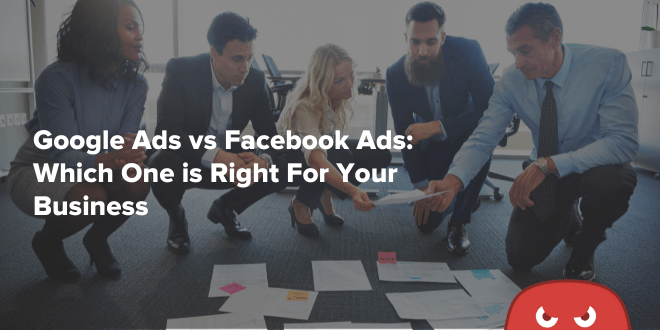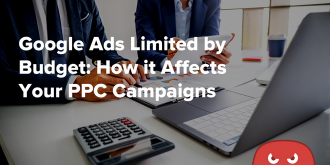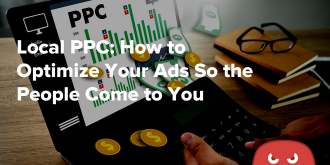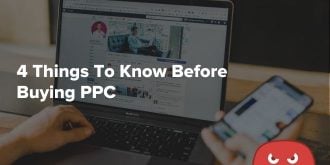Quick Links
With more consumers shopping on the internet than ever before, new businesses must look to the web to market themselves.
But it can be hard to know where to start.
Online advertising platforms like Facebook Ads and Google Ads can help you reach new customers with targeting that traditional marketing can’t match.
But without experience, it’s difficult to know which will work best to promote your product or service.
In this article, we’ll cover the key differences between Facebook Ads and Google Ads. We’ll also look at the strengths and weaknesses of each to help you decide which platform to choose for your first marketing campaign.
What are the differences between Google Ads and Facebook Ads?
Both Facebook and Google have an extensive reach, capturing roughly 50% of the U.S. digital advertising market.
Here’s an overview of both platforms and how they differ.
Facebook Ads
Facebook Ads is an advertising platform that lets you place ads in Facebook’s feed, Messenger, Instagram, and in mobile apps across its Audience Network.
With extensive targeting options, you can reach and engage your audience through various ad formats — images, videos, slideshows, carousels, collections, and more.
Facebook Ads is best for targeting prospects at the top of the funnel and raising awareness for your brand. It’s also ideal for remarketing and building relationships with existing prospects.
Google Ads
Google Ads lets companies reach their audience through text ads that appear in the search engine results when users search for relevant keywords.
Google Ads works under a pay-per-click (PPC) model. This means you only pay when someone clicks on your ads.
The way it works is straightforward — you bid on keywords that are relevant to your products or services and your ads will appear in the search results for those search queries.
Google Ads is great for targeting prospects in the middle and bottom of the funnel.
Someone searching for “buy tennis shoes” has clear buying intent and knows exactly what they’re looking for. Targeting these types of keywords can help drive more conversions.
You can also advertise in Google’s Display Network, an extensive network that consists of millions of third-party websites and Google properties like YouTube and Gmail. Formats for display ads include text, image, and video ads.
Now, let’s dive into specifics for each platform.
Facebook Ads vs. Google Ads: Average costs for clicks, impressions, and actions
While (almost) any business can advertise on Facebook Ads and Google Ads, you’ll need to consider their advertising costs to determine whether you can generate a positive return.
Let’s look at how much these two platforms cost.
Facebook Ads
When you first create an ad on Facebook, you’ll be asked to choose from the following objectives: Awareness, Consideration, and Conversions.
There are four different billing models:
- CPM (cost per mille or 1,000 impressions): Impressions are the number of times Facebook delivers your ads to a user. You’re paying for impressions whether users click your ads or not.
- CPC (cost per click): CPC is how much you pay each time someone clicks your ads. Before you’d pay for any ad click, but that policy changed in 2015. Now you’re only charged for clicks that are relevant to your objectives.
- CPA (cost per action): This pricing model allows you to only pay when users take specific actions. You can set up actions for app installs, completed purchases, and more.
- CPE (cost per engagement): You might consider this pricing model if you want to generate more likes or shares for your posts.
The following shows a full breakdown of average costs for each pricing model:
The factors that affect advertising costs include:
- Audience and demographics
- Location
- Objective
- Time of year
- Industry
- Placement
- Competition
Check out this post on “How much do Facebook Ads cost?” to learn how these factors affect ad pricing and how you can lower your costs.
Google Ads
Google’s advertising platform works on a cost-per-click basis. But how much you pay for each click will depend on the following factors:
- Keyword: Keywords with high purchasing intent (e.g., “buy,” “for sale,” etc.) tend to have a higher CPC than other types of keywords (e.g., “how-to,” “where can I,” etc.).
- Industry: Industries like health insurance and investing tend to have a higher CPC than industries like fitness and fashion.
- Competition: More companies bidding on the same keywords will naturally increase advertising costs.
- Seasonality: Industries that are affected by seasonal changes can expect to pay more or less depending on the time of year.
Perhaps the most important factor that determines pricing is the quality score — a rating that Google assigns to your ads based on their quality and relevance.
Even though Google Ads works like an auction, the highest bidder doesn’t necessarily rank first. That’s because Google considers your click-through rate (CTR), the relevance of your ads, and the quality of your landing pages.
A high quality score can help your ads rank higher and cost you less per click. But a low quality score means you’ll have to increase your bids to achieve a higher ad position.
With that said, the following chart shows the average CPC across different industries:
The average CPC for Google Ads is $4.70 based on the figures above.
Check out this post on “How much does Google Ads cost?” to learn more about how much you should be spending and how you can optimize your ad spend.
Facebook Ads vs. Google Ads: Reach and targeting
Reach refers to the number of potential customers who could see your ads. Of course, you may not want to reach an entire market, as certain segments may be a better fit than others.
Targeting means the ability to reach specific segments of your market. This ensures that your ads are reaching the right people.
Let’s look at how Facebook Ads and Google Ads compare in terms of their reach and targeting.
Facebook Ads
Facebook has an estimated 2.89 billion monthly active users, making it the most popular social media platform in the world.
Facebook offers extensive reach. No matter what products or services you offer, there’s a good chance that your target audience is on this platform.
Your ads aren’t strictly limited to Facebook. You can also have your ads appear on Instagram, Facebook Messenger, and the Audience Network — a display network that consists of third-party mobile apps.
The Audience Network supports the following ad formats:
Facebook estimates that over a billion people see an ad in its Audience Network each month.
You can also create lookalike audiences — a feature that lets you reach people who share similar characteristics with your current customers.
In terms of targeting, Facebook Ads offers great control over who sees your ads.
Facebook Ads lets you reach people based on the following:
- Demographics (age, gender, education, etc.)
- Location
- Behavior
- Interests
- Connections
These options allow you to be extremely specific with your targeting — but you can’t actively target consumers in the middle of a certain action — like researching a product — like you can with keyword-based targeting on Google Ads.
Google Ads
Google’s reach with just its search engine alone is simply staggering. Its search platform generated approximately 89.5 billion visits in June 2021.
Google states that its Display Network reaches 90% of Internet users across millions of websites, including YouTube and Gmail. Google’s Search and Display Network offers greater potential reach than Facebook Ads.
Targeting in Google Ads is based primarily on keywords.
For example, if your business offers fitness products, you might bid on search terms like “build a home gym” or “adjustable dumbbell set.”
Of course, the challenge is determining which keywords to target.
Using tools like our free Google Keyword Planner can help you identify profitable keywords based on metrics like search volume and CPC (a high CPC indicates more commercial intent).
While not as granular as Facebook Ads, Google Ads allows you to add demographic targeting to your ads. For example, you can show your ads to users based on:
- Gender
- Age group
- Parental status
- Household income
This type of targeting allows you to optimize your ad spend. For example, if you sell women’s makeup products, you likely only want to target women (unless you also offer makeup for men).
However, one caveat is that Google’s demographic data isn’t always accurate. Google even states that it estimates demographic information for users who aren’t signed into their accounts.
By using this option, you can limit your reach without greatly improving your targeting. Keywords are the real asset to Google Ads campaigns, and make accurate targeting easier for inexperienced marketers than Facebook campaigns.
Facebook Ads vs. Google Ads: Buying intent
An important consideration when advertising on Facebook Ads or Google Ads is intent — how likely prospects are to make a purchase after seeing your ads.
Let’s take a closer look.
Facebook Ads
Social media users tend to lack a certain intent when they’re browsing the timeline.
When you open Facebook or Instagram, you’re not necessarily looking to buy anything. You might simply be passing the time or seeing what your friends are up to.
You’re not alone.
An estimated 7 in 10 Americans use social media to browse news content, share posts, and entertain themselves.
In other words, most social media users are passive ad viewers. Users may click through, but only on the right ad at the right time.
With Facebook Ads, you’re putting ads in front of people who have little intention of buying anything.
Here’s an ad for a Hokkaido trip planning app that appeared in my Instagram feed:
This ad would certainly catch my attention if I were planning a trip to Hokkaido. But since I’m not (unfortunately), I scrolled past it without clicking.
Google Ads
Google Ads allows you to reach people with high buying intent.
For example, someone searching for “project management software” or “weight loss program” is more likely to buy than someone scrolling through Facebook. They’re actively looking for a solution to a problem.
This high level of intent makes Google Ads ideal for targeting prospects at the bottom of the funnel. A relevant ad with compelling copy can help you drive more conversions.
Here are search ads that appear for “Hokkaido trip planner”:
Because I actively searched for a Hokkaido trip planner, I’m more likely to click these ads and even book a trip.
Facebook Ads vs. Google Ads: Average click-through and conversion rates
Ultimately, you want results no matter what platform you advertise on.
Here’s how Facebook Ads compares to Google Ads in terms of clicks and conversions.
Facebook Ads
Facebook Ads has an average CTR of 0.90% across all industries.
However, when Facebook users do click an ad, they convert at a high rate. Facebook Ads has an average conversion rate of 9.21% across all industries.
The data suggests that users who click through have a high level of intent. They saw an ad that captured their attention and made a purchase (or completed a desired action).
Google Ads
Google Ads has an average CTR of 5.06% on the search network and 0.50% on the Display Network.
Here we can see that Google Ads has a higher CTR than Facebook Ads.
As previously mentioned, search engine users are more intentional with their searches, so they’re more likely to click ads that offer solutions.
The average conversion rate is 4.40% on the search network and 0.57% on the Display Network.
Google Ads may have lower conversions, but it can still generate a high return as your ads are driving more targeted clicks and reaching prospects at the bottom of the funnel.
Google Ads: Strengths and weaknesses
Google Ads can enhance your visibility online and drive targeted traffic to your website. But it’s important that you weigh all aspects of the platform before diving in.
Let’s start with its strengths.
Lets you target consumers at specific moments in time
The problem with traditional advertising like TV commercials and print ads is that you’re not always reaching a relevant audience.
Google Ads allows you to position your business in front of prospects who are actively searching for products or services that you offer.
Of course, you need to have a clear understanding of how keywords affect your Google Ads campaigns to ensure you’re reaching the right people.
You only pay when someone clicks your ads
This is a huge plus.
What makes Google Ads an attractive advertising platform is that you’re paying for results. You’ll only get charged when someone sees and clicks your ad.
What’s more, you have complete control of your advertising budget. Even if you only have a few hundred dollars to spend a month, you can set daily limits and gradually ramp up your spending as you generate results.
Allows you to test new keywords
Search engine optimization (SEO) can improve your site’s rankings in the organic search results. But ranking for certain keywords can take weeks or even months of effort.
Google Ads is a great way to test keywords for an ongoing SEO campaign.
Running ads for different keywords will help you determine which ones are worth targeting. You can even test things like headlines and landing page copy.
Now let’s look at some of the weaknesses of Google Ads.
People inherently trust the organic search results
Organic search drives 53% of website traffic, while paid search drives 27%.
The data shows that online users tend to click the organic results more. Users may scroll past the top results simply because they know those pages are paid advertisements.
Certain keywords can be extremely expensive
Advertising on Google Ads isn’t exactly cheap.
For certain industries, you’re looking at spending several dollars or more per click. Those costs can really add up.
It has a steep learning curve
Getting started with Google Ads has a steep learning curve. If you don’t know what you’re doing, you can quickly burn through your advertising budget.
A good example is not understanding match types. Bidding on broad keywords increases your reach, but it also means targeting people who may not be interested in your business.
If you’re struggling to get started, check out HOTH PPC for fully managed PPC services by trained Google Ads experts.
Facebook Ads: Strengths and weaknesses
Facebook Ads can also help you reach your audience. But like Google Ads, this platform has its own set of pros and cons.
Here are its strengths.
Offers extremely precise targeting
One area that Facebook Ads excels at is its targeting capabilities.
You can narrow down your audience based on age, gender, location, interests, and more. This allows you to reach those who match your ideal customer profile.
It’s relatively inexpensive to advertise
Facebook Ads gives you excellent bang for your marketing buck.
To quickly recap, Facebook Ads has a CPM of $14.67 and a CPC of $1.22. For just $100, you can potentially show your ads to as many as 7,000 people (6,816 to be precise).
Can reach new customers with lookalike audiences
Chances are you already have demographic data about your existing customers.
With this data, you can create lookalike audiences who share similar characteristics. This means you can reach more people on Facebook who are outside your customer list.
Now let’s look at where Facebook Ads falls short.
Harder to reach interested buyers
Social media tends to have lower purchasing intent.
Someone scrolling through their feed isn’t necessarily looking to buy anything. This can be difficult to drive conversions unless you show the right ad at the right time.
You have to moderate your comments
Another potential drawback is that social media users can comment on your ads.
While this can be useful for interacting with your audience, you may also receive negative comments from people who’ve never engaged with your brand.
You can delete comments, but this can cause some backlash and even harm your brand reputation as the ad will show that you’ve deleted certain comments.
Increased competition makes it harder to stand out
There are now an estimated 10 million active advertisers on Facebook.
More competition means higher advertising costs. It also means that catching people’s attention will require investing in more creative ads, which can become expensive.
Facebook Ads vs. Google Ads: Which ad platform is right for your business?
There’s no right or wrong answer here. However, there are some important considerations when choosing one over the other.
It depends on your goals, products, and target market
What exactly are your marketing goals? Do you want to raise brand awareness, generate leads, or drive more sales?
The answer to these questions will help you choose the right ad platform.
If your goals are to raise brand awareness and reach prospects at the top of the funnel, then Facebook Ads is a good fit — it offers exceptional targeting and engaging ad formats.
If your goals are to increase sales and reach prospects at the bottom of the funnel, then Google Ads is a better option — it costs more, but you can target keywords with high buying intent.
Want to sell a cool, trendy product (think fidget spinners) that people don’t even know exist? Facebook Ads. Offer higher-value products or services with longer sales cycles? Google Ads.
Finally, Facebook Ads tends to work better for B2C markets, while Google Ads is better for B2B markets.
You don’t have to choose either/or: Both is often the right answer
The best platform will depend on what your marketing goals are, the products you are selling, and your target market.
But even with a limited budget, you can often get better results by using both channels rather than sticking to just one.
Here are some tips for using Facebook Ads and Google Ads together:
- Cover each stage of the buyer’s journey: You can use Facebook Ads for building brand awareness and Google Ads for targeting prospects in the middle to late stages of the buyer’s funnel.
- Leverage retargeting: Not every visitor to your website will perform a desired action. Both platforms offer retargeting features that let you bring visitors back to your site as they browse their Facebook feed or visit sites in the Display Network.
- Use Google Ads traffic to drive sales and train your Facebook Pixel: A Facebook pixel is a snippet of code that you add to your site. It tracks the actions people take on your website. The more conversions your pixel has, the better it gets at delivering your ads to people who are likely to take similar actions.
Conclusion
Facebook Ads and Google Ads are advertising platforms that you can leverage to position your products or services in front of the right people.
One platform isn’t necessarily better than the other. However, using both platforms can help you cover the entire buyer’s journey and gain more exposure for your business.
Need help creating Facebook Ads or Google ads for your business? Then schedule a call with our PPC experts.
























